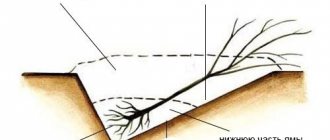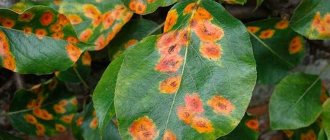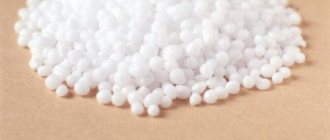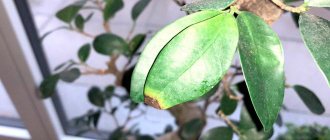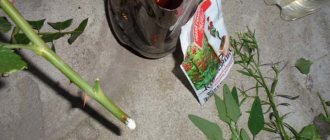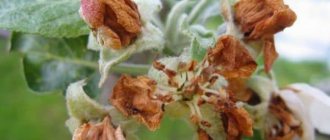The need for cuttings
The duration of intensive fruiting of apple trees is several years, then the volume of the harvest begins to gradually decrease.
Ultimately, there is a need to renew the garden - replacing mature trees with young seedlings. Also, the process of propagating apple trees by cuttings is resorted to in order to increase the area of the apple orchard by planting young trees taken from time-tested specimens. Gardeners have the opportunity to purchase recently bred hybrid varieties with high fruiting from the nursery. However, given the unique climate in most regions of the Russian Federation, there is no guarantee that new varieties will give the expected results. To avoid such risks, most gardeners prefer planting material taken from their own plots, since their own apple trees have already adapted to a specific climate, survived many winters and demonstrated productivity.
Cuttings are the optimal way to rejuvenate the mother tree, which can be carried out almost at any time of the year.
Transplant method
This method is perhaps one of the simplest. It does not require special knowledge, tools or gardener training. It is carried out in early spring, 3 weeks after the snow cover has completely melted.
The essence of this technique is that root shoots are dug up and transplanted to another place. They are easily separated from the root, take root well, are distinguished by early fruiting and high yield.
Apple tree propagation by transplantation.
The only problem: not all varieties of apple trees pass on their qualities to offspring obtained in a similar way. In this case, the resulting seedling can be grafted from the same mother tree. Then you will get an improved fruit-bearing tree: it will gain better winter hardiness and resistance to diseases.
The right time to take cuttings from an apple tree is summer.
The ideal time for cutting cuttings is summer: the period from late June to early July, since at this moment the leaves of the planting material should already be fully developed.
The harvesting procedure can also be carried out in the fall, in which case the cuttings are subsequently used for grafting. To store them, it is necessary to arrange a place in a dark basement with damp sand and the possibility of regular ventilation.
The recommended time for cutting is dawn, since that is when a large amount of moisture accumulates in the shoots.
A cutting filled with sufficient moisture is most suitable for propagation.
It is not recommended to harvest in the spring due to the high risk of damage to the mother tree.
Original rooting methods
Despite the fact that most gardeners and summer residents prefer the classic method of rooting cuttings, some prefer to experiment and offer their own methods. Many people use the following for rooting:
- decoctions from tree branches;
- potato tubers;
- peat tablets.
If you need to root seedlings in potatoes, then you need to prepare a healthy and large tuber and remove all the eyes from it. Then the cutting is stuck into it, the tuber is buried in the soil and covered with polyethylene on top. In the future, such a seedling needs to be cared for, as with classical rooting: it must be ventilated, watered and sprayed on time.
It is believed that due to the high content of nutrients and starch in potatoes, this method will allow the plant to take root better.
To take cuttings using a decoction of branches, you need to cut willow shoots and fill them with water, then bring to a boil and cook for about 10 minutes. The resulting broth is first cooled and then filtered. And after that, a seedling is placed in it for rooting.
Propagation of orchids using cytokinin paste
As for the use of peat tablets, they have the following advantages:
- nutritional value;
- tablets are air and water permeable;
- sterility.
Such tablets are compressed peat or coconut fiber. They need to be filled with water so that they swell to the desired size, and then the prepared cuttings are placed in them.
There are different methods for cutting plants, largely depending on the type of plant and climatic conditions. But in any case, you must first study all the details of the process in a given case and strictly carry out all care measures.
Rules for taking cuttings
The preparation of planting material must begin in winter, since the formation of the root system in summer cuttings is poor. This process should be carried out as follows:
At the end of December, select a branch from the apple tree aged 1 to 2 years, the bark of which is completely free of any damage.- Break the process at the base and fix it in a bent position with electrical tape or adhesive tape.
- With the onset of spring, cut the branch at the break point and place it in an opaque container with warm water that has had time to settle. For this case, it is recommended to use melt water whenever possible.
- For disinfection purposes, it is advisable to dissolve 2 tablets of activated carbon in water.
- During the entire time the branch is in the vessel (usually it takes 20 days), it is necessary to periodically add fresh water.
At the end of this period, a thickening can be observed at the cut site, on which roots will subsequently begin to form. After the formation of the first shoots, it is permissible to begin the rooting process.
It is recommended to cut and prepare several shoots at once, this will increase the likelihood of obtaining planting material of the desired quality.
Preparation
The procedure for propagating an apple tree at home is carried out only after preparation. First, the tree is inspected for diseases and damage. If signs of disease are detected, the apple tree is cured.
How to make a pyramid bed for strawberries with your own hands, dimensions and cultivation
After this, the material is prepared with the help of which reproduction will be carried out. It is impossible to prepare a large amount of material at once, so that it does not disappear. If you decide to propagate an apple tree using cuttings, you need to remove all the leaves from it.
When working, use only sterilized tools to avoid infecting the tree. To do this, use special chemicals (copper sulfate or “Crisp”) and folk remedies (potassium permanganate or ammonia). The preparations are diluted according to the instructions so as not to burn the material during work, but to remove all bacteria and fungi.
You will need:
- 2 liter plastic bottle;
- large plastic bag (up to 40 cm long);
- substrate.
Garden soil, humus or sawdust are used as a substrate. You can mix manure with compost or soil with vermiculite in a 1:1 ratio. Its properties help it retain moisture in the soil.
Good germination of seedlings is observed if sphagnum is used as a substrate. Don't forget to water it every few days.
Periodically, the substrate is replaced with ready-made cotton wool cubes for hydroponics. Due to its sterility, it is used several times per season. Do not forget to regulate the moisture level of the cotton wool, because... otherwise it will lose its beneficial properties.
Rooting methods
Usually, after the roots appear and reach a length of 5–8 cm, the cuttings are immediately planted in the ground. In addition to the bed, there are several other rooting options that give equally effective results.
In potato tubers
Despite its unusual nature, this method is quite productive and is suitable for all types and varieties of apple trees, including columnar ones, known for their capriciousness.
For the procedure, select a large tuber without mechanical damage and not affected by diseases. The potatoes are washed well, the eyes are removed, and then a cutting is placed in its pulp and dug in in the sand or soil.
A film cover is created on top, which allows you to get a greenhouse effect.
Using woody cuttings
For this method, select absolutely healthy shoots aged 1 to 2 years, located on the southeastern or southern side of the mother tree. Planting material should be taken from the middle part of the crown.
In this case, rooting can be done anywhere: in a regular room, in a greenhouse or outdoors. The last method requires organizing a kind of greenhouse.
At home, boxes are well suited for this procedure. To prepare the substrate, universal soil purchased at the store is mixed with straw in a ratio of 1:3. In this particular case, straw acts as a leavening agent.
Rooting outdoors involves mulching, which retains moisture in the soil and prevents the roots from drying out.
Breeding apple trees using lignified cuttings has a number of advantages:
- preservation of varietal characteristics;
- the possibility of propagation by cuttings of apple trees of any age;
- the permissibility of sending and transporting cuttings over any distance without significant financial costs.
The disadvantages of this method include the rooting process being too long.
In a wooden box
The container is filled with substrate and several cuttings are placed in it at the same time, after which they are placed in a warm place.
In the room where the cuttings are rooting, it is necessary to ensure high-quality ventilation.
In the process of caring for planting material, drip irrigation is performed.
Planting in open ground
As a rule, several young apple trees are planted on the street at once. Most often, the trench method is used for this purpose, which increases the chance of obtaining several high-quality specimens.
Before planting, the soil is pre-prepared and filled with fertilizers. In the future, young shoots require proper care: watering, fertilizing, loosening the soil.
Own-rooted fruit trees: how to grow apple and pear trees from cuttings
In one of the previous articles, we already talked about the method of preserving the variety of your favorite apple tree (or other fruit tree) without grafting - using air layering. The method is certainly good, but there are others.
Tell me, would you like apple and pear trees to reproduce as easily as currants? I cut the cuttings, rooted them, planted them and everything was in order! Dreams, dreams... Not such pipe dreams, as it turned out. Gardeners have tried to grow a pear or apple tree from cuttings and many have succeeded. It’s worthwhile for us to master this method, isn’t it?
Grafted and own-rooted apple and pear trees
The vast majority of fruit trees in our gardens are grafted. In some nursery they grafted a wonderful variety of apple or pear onto some rootstock, sold us a ready-made seedling, and we planted it with the hope of a harvest. However, hopes are not always justified.
There are a lot of nurseries selling seedlings, but few people think about the compatibility of rootstock and scion. As a result, we often end up with sickly apple trees that are unstable to winter cold and have small fruits. And pears can die from incompatibility between the rootstock and scion.
An alternative to grafted seedlings are self-rooted pears, apple trees, cherries, plums, etc. They are grown from cuttings of varietal trees, they do not need grafting, which means there are no compatibility problems for them. Self-rooted trees have two more advantages: they better tolerate high groundwater levels (very important for pears) and they are easy to propagate further, either by cuttings, layering, or through root shoots.
We in no way claim that grafted seedlings are evil, and seedlings on their own roots are ideal for everyone. It also happens the other way around. Growing pear and apple tree seedlings from cuttings is not a panacea for all ills and problems, but just another way of vegetative propagation of fruit trees.
What varieties of apple and pear trees take root well?
Not all varieties of apple and pear trees produce roots equally well when propagated by green cuttings. Some take root better and faster, some take longer and worse. The smaller the fruit, the easier it is for the cutting to take root.
The best varieties of pears for growing from cuttings: Lada, Moskvichka, Naryadnaya Efimova, Osennyaya Yakovleva, Pamyat Zhegalova.
The best varieties of apple trees for growing from cuttings: Altai dove, Altai dessert, Altai ruddy, Aport Alexander, Aport blood-red, Vityaz, Gornoaltaiskoe, Long, Zhebrovskoe, Zhigulevskoe, Kitayka Saninskaya, Kuznetsovskoe, Mechta, Moscow red, Otsovsky renet, Nakhodka Lebedyanskaya , Altai pepinka, Saffron pepin, Gift for gardeners, Ranetka Ermolaeva, Ranetka purple, Severyanka, Ural liquid, Flashlight.
Horizontal planting of seedlings
One of the options for obtaining your own rooted apple tree suggests doing without cuttings at all. But for this you need a ready-made two- or three-year-old seedling of the desired variety. Which seedling – grafted or self-rooted – does not matter.
In the spring we plant our seedling, placing it horizontally in the planting hole.
The side shoots of the seedling should be pulled out of the hole, set vertically and tied to pegs. At the junction of the side shoots with the trunk, you can make notches, a ring cut to remove a strip of bark, or a constriction with copper wire to speed up root formation.
The roots and trunk of the seedling are covered with soil as in the usual planting of an apple or pear tree. Any tree tends to grow upward, so the side shoots will begin to grow as independent trees, and perhaps new vertical shoots will appear from the dormant buds of the seedling trunk. After two years, these shoots will produce small roots at the base and on the trunk. And in the third year, each of them will have their own normal roots.
After this, the seedlings can be separated from the mother plant and grown separately for 1-2 years. And if you want, you can experiment - do not separate the young shoots, leave them to grow in the form of a kind of hedge.
Propagation of apple and pear trees by cuttings
If we do not have a young seedling or we need seedlings of the same variety as the existing adult fruit-bearing apple tree, we will have to take the cutting route. We will need so-called green cuttings - young shoots, the lower part of which has already begun to turn woody, while the upper part remains green. On such shoots, all leaves except the top one should already be open. In the middle zone, the optimal time for cutting cuttings occurs, as a rule, in the second half of June, in cold regions with a long spring - at the end of June - beginning of July.
It is best to cut cuttings in the morning, when they are saturated with moisture. The shoot is cut with a sharp grafting knife closer to the buds. The bottom cut should be at an angle of 45° towards the bud, without cutting it off. The upper cut is made horizontally above the kidney. From one shoot you can get two or three cuttings.
Each cutting must have at least three leaves or two internodes. The bottommost sheet should be removed, leaving only the top two. The remaining leaves are shortened by half to reduce moisture evaporation. If the internodes are short, the cutting is made with three internodes.
Now the green cuttings are kept in a solution of a root formation stimulator for 18 hours. It is advisable to put a plastic bag on the container with cuttings to increase the air humidity inside.
During this time, you need to prepare a box for the cuttings. The box should be approximately 30-35 centimeters high. Nutrient soil (humus, compost, black soil) is poured into it to a height of 20-25 centimeters. Then apply sand calcined in the oven for the remaining 4-5 centimeters. Calcination is mandatory; the top layer must be sterile. Before planting, the substrate is watered (for this purpose, you can again use a root formation stimulator).
The prepared cuttings are buried in the sand by 1.5 - 2 centimeters. It is not necessary to go deeper, otherwise the cuttings may rot. The cuttings are planted so that their leaves do not come into contact with each other, with the box or with the film with which it will be covered. This is important; a leaf stuck to something has a greater chance of rotting and dragging the entire cutting along with it.
The box is covered with film and placed in a greenhouse or greenhouse. It is advisable to choose a place for the box that is bright, but sheltered from direct sunlight. Now once a week it is necessary to ventilate the cuttings and constantly monitor the soil moisture. Both the top and bottom layers should be damp (but not soggy).
It is better to water the plantings using a spray bottle.
Rotten leaves and cuttings, if any, are removed as quickly as possible.
In a month, the cuttings may already have their first roots. Now they can be ventilated more often, gradually accustoming them to “fresh air”. In autumn, a box with cuttings is buried in the ground in the garden, flush with the edges. And the cuttings are covered with pine needles, peat or sawdust.
The next year, young seedlings are planted in a separate bed for growing. And in another two years they will be able to be planted in a permanent place.
There is another popular way to root cuttings of fruit trees: not in a box, but in a champagne bottle. This is done like this: the green shoot is cut off completely at the very base, the bottle is filled with chilled boiled water, the shoot is placed in the bottle and sealed tightly. Var or wax is used for this purpose.
The bottle is placed in a pre-dug hole and covered with earth. Now cut off the top of the shoot, leaving two or three buds above the surface of the soil. The top of the seedling is covered with film or a large plastic bottle. They also ventilate and water if necessary. After two or three years, the seedling from the bottle can be transferred to a permanent place: it should already have good roots of its own.
Grafting method
A common method among gardeners is cuttings using grafting, which has its own advantages. Direct rooting of a cutting taken from an old mother tree into the ground is less effective than grafting. In addition, with the help of grafting, it is permissible to grow several varieties of apple trees on one tree at once, since an adult specimen over the age of 7 years can easily tolerate several graftings.
For the process to be successful, you need to choose the right rootstock tree. In this case, it is best to use wild apple trees, since they are characterized by rapid adaptation and viability.
If you plan to grow one variety, it is recommended to graft the cutting directly onto the roots of the rootstock tree. For this purpose, use a one-year-old shoot from which the leaves have been completely removed.
Cuttings must meet the following requirements:
- the presence of 3–4 healthy kidneys;
- the presence of a smooth, oblique cut.
There are several ways to perform vaccinations
Budding
The budding method is characterized by ease of implementation and good survival rate. For the procedure, it is necessary to use completely dormant buds, it is best if they are from last year. The optimal time for budding is early spring or the first days of August. All operations are performed in a certain sequence:
- A reliable shoot is selected on the rootstock, growing at least 25 cm from the surface of the ground.
- In the selected location, cut the bark to a depth of 2–3 mm so that the letter “t” is formed.
- Gently lift the bark and press the scion to the exposed area.
- The grafting site is wrapped with a strip of plastic film, leaving the bud free. Only the bud base should be tightly pressed to the apple tree.
The result of the procedure can be observed after 2 weeks.
Into the cut
To graft into a cleft located on the side, you should use a special knife sharpened only on one side (where the chamfer is located). The work algorithm is as follows:
- The tip of a pre-prepared cutting is cut off.
- To engraft the scion, select a branch on an adult tree and retreat 250 mm from the place where it is adjacent to the trunk.
- At the selected location, make an incision with a knife at a depth of 8 mm.
- A cutting is inserted into the resulting crevice.
- The damaged area is treated with putty and then covered with polyethylene.
For the bark
For trees over 3 years of age, bark grafting is optimal. This method is recommended in regions where, due to climate conditions, the development of apple trees occurs less intensively. It is permissible to graft only in spring and use no more than 4 cuttings at a time. The procedure includes several stages:
- On the apple tree, choose a place located from the ground at a distance of 1 to 1.2 m.
- Create a 5 cm long cut by cutting through the wood with a sharp knife.
- Carefully move the bark.
- A cutting with a trimmed lower end is inserted behind the bark.
- Wrap the grafted area with plastic wrap.
When preparing cuttings, it is necessary to take into account the direction of growth of the buds - they should “look” up.
How to propagate an apple tree by cuttings without grafting?
The so-called “green cuttings” of an apple tree for direct rooting in the ground ( without the use of grafting ) is carried out using a long branch that is not cut off from the mother plant so that nutrition does not stop. Separation of the layering is carried out only after the formation of roots.
The procedure is carried out on the basis of a young apple tree using two methods:
- The mother tree is initially planted at an angle;
- The air layering method is used.
Possible errors and failures
During the cutting process, a gardener may encounter several problems. One of them is the preparation of planting material in the spring. In most cases, cuttings cut during this period do not take root, since they have underdeveloped roots. This is due to the active movement of sap in the spring, which does not allow obtaining a high-quality cutting.
Another common mistake among novice gardeners is grafting to the end of a branch, which leads to rejection. To achieve the effect, the cutting must be grafted directly at the base.
The reason for poor survival often lies in insufficient protection from harmful microorganisms, therefore, when cutting cuttings, mandatory treatment of the cut sites with garden pitch or other similar means is necessary.
Planting cuttings
- Greenhouses or greenhouses are used for planting cuttings. If there are few cuttings, then they can be planted in small pots of several pieces, depending on the size of the cuttings.
- A layer of soil (10-15 cm) mixed with sand is placed at the bottom of the pot. The second layer on top is coarse-grained clean sand (3-5 cm).
- With a thin stick (for example, a pencil), holes are made in the soil 2.5-3 cm deep. Then the finished cuttings are placed vertically in them at a distance of 4-7 cm from each other. Using the same stick, compact the soil around the base of the cutting.
- The cuttings are carefully watered from a watering can with a fine sieve. For planting, a mini-greenhouse is built from film. If the cuttings are planted in a pot, you can cover it with a transparent bag on top and secure it with an elastic band at the bottom, at the base of the pot. This will create a mini-greenhouse that can be left on the windowsill at home.
Be sure to shade all planted cuttings!!!
Rooting green cuttings
The survival rate of planting material rooted in this way ranges from 30 to 60%. At the same time, the varietal characteristics of the donor are fully preserved. The procedure itself consists of several steps:
- The cut green shoot is placed in water with activated carbon diluted in it.
- To stimulate root growth, special preparations are added to the container.
- After the formation of the first roots, the cuttings are planted in the prepared substrate, and after 2 years - in a permanent place in the ground.
This method does not allow the use of cold water; the best option is room temperature. To prevent rotting of the roots, the water must be changed regularly and activated carbon must be added.
When rooting, there should not be more than 2 cuttings in one container.
Preparation of green cuttings
For this method, select shoots under one year of age with well-formed wood at the base and the presence of at least 3 buds. The ideal time for cutting cuttings is June, and the time of day is morning. A cut is made directly under the lower bud of the cutting, removing the bottom leaf. In order to reduce moisture evaporation, the remaining 2 sheets are cut in half.
For quick rooting, it is advisable to take shoots from the lower part of the mother tree.
Before placing the seedling in a container, its lower leaves are completely removed, and its upper leaves are partially removed.
Propagation by cuttings
For successful propagation, cuttings must be taken at the right time , especially for plants that change their growth patterns depending on seasonal changes.
One of the main advantages of cuttings over propagation from seeds is the predictability of the result, because each plant cell has the ability to copy all parts and functions of the plant.
But not all plants are able to reproduce in this way; there are plants whose cuttings do not send out roots or take too long to do so.
This method involves taking part of a plant and making a new one from it.
The success of this method depends both on the quality of the cuttings and on the care taken.
There are different types of cuttings.
Two methods are used to propagate most houseplants: stem cuttings and leaf cuttings .
For both cutting methods, the ideal time to perform this operation at home is from March to August.
What plants can be propagated by cuttings?
Many garden crops can be propagated by cuttings. Roots well:
fruit bushes - currants, gooseberries, blackberries, grapes;
coniferous plants - cypress, thuja, juniper;
flowers - rose, hydrangea, forsythia, mock orange.
Cuttings taken from young mother plants, which should be strong and healthy, take root better.
Flower cuttings
Typically, cuttings are best prepared from annual growths. The lower cut of straight and even cuttings must be made 0.5-2.5 cm below the node, and the upper cut - somewhere the same amount above the upper node. For hollow-stemmed flower crops, such as forsythia or chebushnik, the cutting is cut just below the node, where the denser tissues are located. If you cut the cutting differently, it will rot before it takes root. Cuttings take root in one to two months.
To distinguish the upper end of the cutting from the lower, you can make the upper cut straight and the lower cut obliquely. To prevent moisture from evaporating, the upper cut must be treated with garden varnish.
Roses lend themselves well to propagation by cuttings. This method is best suited for pink and red varieties, but yellow varieties are difficult to take cuttings
Many people think that they can make cuttings from a given bouquet of roses. But such flowers rarely take root, since various preservatives are used to preserve them. For cuttings, it is better to use flowers from bushes that grow in a flower bed or garden.
Cuttings of berry crops
In the spring, shoots of currants, gooseberries, sea buckthorn and honeysuckle are cut into cuttings. The size of the cuttings is 15-18 cm, it should consist of 2-3 buds. For propagation, you can take any parts of the shoots, but you need to take into account that the tops take root much worse. When cutting above and below the bud, it is necessary to leave at least 1 cm.
Green cuttings are one of the easiest ways to propagate most berry bushes.
Cuttings need to be planted from May 1 to May 20, since the formation of roots requires a temperature of at least 8-10 degrees. The survival rate of cuttings in a greenhouse is, of course, better, but they can also be planted in beds. The soil must be prepared from equal parts of earth, peat, humus and river sand. The thickness of the substrate must be at least 20 cm
Cuttings must be planted obliquely, so that the top bud is at soil level. Planting pattern: 10-12 x 15-20cm. It is not recommended to plant more densely, as the plants will form weaker. After the cuttings are planted, the soil needs to be compacted and mulched with 1-1.5 cm of fine humus. You need to water the cuttings often: once a day, so that the soil does not dry out, but also not allow excessive dampness.
Attention! It is the substrate that needs to be watered, not the cuttings. Otherwise, the hormones formed in the leaves will begin to draw out nutrients, and root formation will be poor.
An indicator of good survival rate is the germination of buds and the appearance of sprouts. After this, the cuttings no longer need to be watered as often, only as needed.
1-1.5 months after planting the cuttings, you need to carefully check how easily they are pulled out of the soil. If it is easy, then the roots have not yet formed, but if this requires some effort, then it is better not to touch the cutting - rooting has already occurred. It is at this time that it is advisable to feed the cuttings with mineral fertilizers.
Cuttings of coniferous and evergreen plants.
For coniferous and evergreen plants, propagation by cuttings is considered the most productive and reliable. This method 100% guarantees the preservation of varietal characteristics. But it is also more complex, as it requires compliance with special rules and conditions.
The mother plant from which cuttings are supposed to be taken should be no more than five years old, because cuttings from older plants take root much worse.
On a healthy mother plant, you need to select last year's shoots and carefully break out small branches with a “heel” - a piece of old wood with bark. This must be done with a sharp movement. The cuttings should be 10-15 cm high.
Then you need to cut the heel in half and remove the lower needles to half the cutting. It is necessary to cut off the young green top of the cuttings - the growth cone, as it will take away the energy of the plant necessary to produce roots.
Moisten the cuttings with water and dip them in the rooting agent Kornevin or place them in the growth stimulator Epin or Heteroauxin for about 10 hours and place them in a dark place.
Attention! The growth stimulator can only be used at night, because in daylight the active substance in it is destroyed. The growth stimulator should be diluted in slightly acidic water, since an alkaline environment is also detrimental to it.
Make a hole in a mixture of peat with sand or perlite with a knife or stick and carefully, so as not to rub off the rooting powder, plant the seedlings, immersing them halfway in the ground. The soil near the stem should be thoroughly compacted and watered. Other cuttings are planted at a distance of about 5 cm.
The bed must be watered with a fungicide solution and covered with film. Don’t forget to water and ventilate the plants, preventing the soil from drying out. The film can be removed when growth appears on the plant. But this does not mean that the cuttings have roots. Seedlings begin to grow only when they develop callus, which forms around the cut site. As it grows, it will close the wound and thus protect the cuttings from rotting. New roots in cuttings appear from the callus or above it, from the stem.
After this, it is recommended to spray the young conifers frequently, otherwise they will simply burn in the sun. Therefore, you need to take care of proper humidity and diffused sunlight.
In deciduous shrubs, roots appear in about 2-3 weeks, in cypress - within two months, in thuja - from 45 to 60 days, in juniper, root formation can take up to three months.
There is a very interesting method of propagating flowers and evergreens. It involves using potato tubers instead of water. To do this, a large potato must be completely cleared of its eyes and a prepared cutting must be inserted into it.
After this, bury the root crop with a twig in the ground and cover with a cut plastic bottle or glass jar. A cutting planted in this way must not be forgotten to water regularly. After some time, when it takes root and begins to produce leaves, the cover can be removed. The secret of cuttings using this method is that the shoot immediately receives a large amount of nutrients from the potato tuber. This helps it develop well and quickly form its own root system.
As you can see, propagating your favorite plant varieties by cuttings is not at all difficult. You just have to want it. Good luck and rich harvests!
| Plant | Cutting time | Rooting percentage | Duration (days) |
| Rose | Budding - beginning of flowering | on average, 83.9%, in some varieties up to 100% | from 10-15 to 28 |
| Lilac | Flowering phase | up to 90-100% | |
| Clematis | Budding - beginning of flowering | 40-100% depending on the variety | 25-30 |
| Chubushnik | Decay of shoot growth - beginning of flowering | up to 90-100% | 15-25 |
| Spirea | Early-mid June | from 30 to 100% in different species | 12-25 |
| Forsythia | First half of June | up to 70% | 20-30 |
| Kalina | Flowering period | 100% | 14-21 |
| cotoneaster | Late June-early July | 100% | |
| Deytsia | Early June-mid July | 100% | 17-25 |
| Privet | Mid June-early July | 80-90% | 14-21 |
| Derain | Mid June-early July | 100% | |
| Honeysuckle | End of shoot growth | 100% | 11-20 |
| Hydrangea | June July | 80-100% | 20-23 |
| Rhododendron | July-September | 72-76% | 50-70 |
| Actinidia | June July | 36% | |
| Skumpia | Late June-early July | 100% | 20-30 |
| Barberry | June | 33-100% | |
| Kolkvitsia | Early July | 46% | |
| Weigela | 100% | ||
| Euonymus | 45% | 45 | |
| Currant | 83% | ||
| Chaenomeles | 100% | ||
| cotoneaster | up to 100% | up to 28 | |
| Keria | up to 100% | ||
| Kuril tea | 100% | ||
| Juniper | 70-90% | ||
| Thuja | June | 30-60% | 30-60 |
| Spruce | June July | 50% |
Propagation by root cuttings
Root cuttings are fragments of roots extracted from the ground and capable of forming shoots from “dormant” buds. This method makes it possible to grow a large number of healthy seedlings in a relatively short period of time, producing abundant harvests in the future.
Since the formation of root cuttings occurs on the root system of an adult apple tree, the planting material is characterized by high viability.
The difficulty of propagation by root cuttings lies in the fact that high-quality cuttings can only be taken from young, rooted trees aged 5 to 7 years. In older specimens, shoot formation is reduced.
Procurement operations
Obtaining root cuttings occurs according to the following algorithm:
- In the fall, the roots of donor apple trees are cut off with a diameter of up to 1 cm, and then they are cut into segments 10 to 15 cm long. The ends that were located close to the trunk are marked.
- The blanks are placed in a container with sand, sprinkled on top and left in a cool place for the winter. A cellar is well suited for this purpose.
- With the onset of spring, the cuttings are placed at an angle in a box filled with damp sawdust and placed in a room at room temperature. In about 21 days, shoots form on the material and buds swell.
From harvested apple trees, only scion seedlings can be obtained, but not varieties planned for breeding.
Technology, advantages and disadvantages of different methods of apple tree propagation
Methods of propagation of apple trees have their advantages and disadvantages. Read below about all the nuances and features of plant propagation.
Cuttings
For vegetative propagation by cuttings, choose annual, non-lignified shoots that have 4-5 buds.
- The advantages of the cutting method are:
- the possibility of rejuvenating old wood;
- procurement of planting material can be done in any quantity, from April to October;
- obtaining seedlings for rootstock.
- The disadvantages of this method are:
- duration of the rooting process.
Air layering
To propagate a fruit tree without grafting, you can use layering. The technology of propagation by air layering is based on the characteristics of the cambium tissue, which is located between wood and bark and can form roots at the site of damage.
The film “sleeve” on the apple tree shoot helps soften the bark. The advantage of the method is the speed of obtaining a seedling with a developed root system. It will take only six months to carry out the process of growing rhizomes. The disadvantage of propagation by air layering is the laboriousness of the procedure and the requirement of certain skills in the field of gardening.
Seeds
The seed propagation method is most often used in nurseries to develop new crop varieties. Seeds from pollinated apple trees are planted in the ground after undergoing selection and stratification. To begin with, you need to choose the right variety for propagation.
According to Michurin’s classification, in nature there are 3 groups of varietal crops, which differ in the quality of transmission of genetic information to offspring:
- The first group consists of varieties that are capable of transmitting their qualities to their offspring in full, provided there is no cross-pollination with wild animals. The group includes almost all large-fruited Chinese, Antonovka, Muscat, Skrut, Pineapple white.
- The second group consists of plants with a low-stable ability to transmit genetic information to offspring - Babushkino, Grushovka, Borovinka.
- The third group includes varieties that, without meeting certain conditions, are capable of transmitting genetic information - Green Renet, Anise, Vorgulet, Saffron Pepin, Volga Turnip.
To cultivate a cultivated variety without grafting, it is better to give preference to seeds from the third group. If you need to grow a long-known variety, you must first prepare a frost-resistant wildflower and graft a cultivated variety onto it.
- The advantages of the seed propagation method are:
- obtaining a qualitatively new variety that will be resistant to diseases and low temperatures;
- Apple trees grown by seed are distinguished by their longevity.
- The disadvantage of this method is:
- low germination of seed material;
- seedlings grown from seeds can only be used as a rootstock;
- late dates for the onset of fruiting.
Video: growing an apple tree from a seed
Without vaccination
The technology of propagation without grafting is to create an artificial stimulus for the plant to grow and root. Cuttings that need to be placed in a moist, nutritious environment for root formation are excellent for this purpose.
- The advantages of the method without grafting are:
- high percentage of rooting of cuttings;
- obtaining a high-quality seedling, without a long and difficult grafting process.
- The disadvantage of this method is:
- duration of growing planting material.
Budding
The process of budding is the grafting of eyes taken from one-year-old tree shoots onto the rootstock.
- Advantages of the method:
- unlimited amount of grafting material;
- obtaining up to 4 developed crowns on one plant;
- the ability to get different fruits on one tree, for example, apples and pears.
- The disadvantage is:
- the impossibility of carrying out the process in rainy, humid weather.
- The budding process can only be carried out in the autumn.
Technology of rooting apple tree cuttings
To obtain a seedling with a complete, healthy and strong root system, the cuttings must be germinated. The rooting technology is quite simple and is carried out using two methods: in water and soil.
Important! The cutting is planted in open ground when its roots reach a length of at least 7 cm.
In water
Germination of cuttings in water is carried out according to the following algorithm:
- The top part of a dark plastic bottle is cut off, and the height of the bottle should be slightly less than the length of the cuttings.
- The cuttings are placed in a container and filled with water so that it covers the lower bud (about 5-6 cm). Special natural or store-bought root growth stimulants are added to the water - for example, aloe juice or Kornevir.
- Over the course of two weeks, the water is periodically changed to new water. During this time, a thickening should appear in the lower part of the cutting, which is located in the water.
- By the end of the third week, root shoots appear on the planting material.
In the ground
You can also root cuttings in the ground. To do this, in early spring they do this:
- A specially prepared substrate consisting of equal parts of sand, peat and black soil is poured into a plastic container.
- Before planting in the ground, the planting material is placed in a solution of a root formation stimulator.
- The cuttings are deepened into the ground by 5-6 cm, the surface is thoroughly moistened.
- To create a greenhouse effect, the container is covered with plastic film.
- When stable warm weather sets in, the container with the cuttings is taken out into the open air.
- After root shoots form on the seedlings, they are transplanted into open ground.
Apple tree propagation time
The timing depends entirely on natural conditions, as well as on the chosen propagation method. Basic recommendations:
- grafting with cuttings is best done in winter or spring, grafting with eyes - in summer;
- seeds germinate at any time of the year, but seedlings are planted in spring or autumn after 1–2 years with a completely lignified stem;
- digging is done in the summer, the seedling is transplanted in the spring of next year;
- air layering is obtained in the summer, rooted seedlings are transplanted to a permanent place in the fall or spring of next year;
- green cuttings are cut in the summer and planted in a permanent place in the fall or spring the next year.
Reproduction methods
The apple tree is not the most capricious tree to reproduce. However, before you get down to business, it’s worth understanding what home methods exist. To be on the safe side, you can use several methods. How does an apple tree reproduce:
- seeds;
- cuttings;
- layering.
Propagation using seeds seems to be the simplest and most logical. However, there are difficulties: firstly, it takes longer, and secondly, you may not get the variety you expected. The fact is that when grown from seeds, trees acquire a different genetic set. Therefore, this method is used to breed new varieties. Of course, out of curiosity, you can try to germinate the seeds and get a shoot from them, but you should not rely on this option. Most likely, the result will be a wild apple tree with small apples.
The most successful methods are propagation using layering and cuttings.
Propagation of apple trees by air layering
A reliable method that allows you to obtain cuttings from an old apple tree while preserving the varietal characteristics of the donor tree. Propagation by air layering, as well as obtaining cuttings using the broken branch method, is based on stimulating damaged tissue to increase the formation of phytohormones, which accelerate root formation. This is where the similarities end, and an interesting process begins. The best time for the operation is spring.
Preparation for reproduction
To carry out the operation you need to prepare the following:
- opaque plastic sleeve or bag 30-40 cm long;
- dark plastic bottle 1.5-2 l;
- special soil.
As a soil mixture, you can use garden soil with the addition of sand, humus, and moss. A mixture of garden soil and vermiculite is also suitable for this purpose. The main thing is that you do not need to add any fertilizers or mineral fertilizers to the soil mixture.
Apple tree propagation by air layering.
Choosing and preparing an escape
As a future cutting, you need to choose a healthy, unbranched branch 2-3 years old, bearing fruit last year, with fresh growth. The thickness of the branch should not be greater than the diameter of the neck of the bottle.
- In the spring, before the leaves appear, a plastic sleeve is put on the chosen branch, both edges of which are secured to the branch with electrical tape. A greenhouse effect is created under the film; the bark of the branch softens under such conditions. Softening makes further manipulations easier.
- In June, the sleeve is removed from the branch: the electrical tape securing the upper edge of the sleeve is unwound and the film is folded down towards the trunk.
- Find last year's growth on the branch, move 10 cm away from it towards the trunk and cut off a 1 cm wide ring of bark around the branch. Then several oblique cuts are made on the bark below and above the ring. These cuts will speed up the root formation process.
- Then they begin to assemble the structure in which the process of forcing the roots will take place. A bottle with the bottom cut off is placed on the branch with the neck down (towards the trunk). The ring cut on the branch should be located closer to the neck of the bottle (but not close).
- The sleeve is put over the bottle and tied to the neck with electrical tape. It is recommended to fix the branch with the bottle in a vertical position.
- A root-forming biostimulator solution prepared according to the instructions is poured into the bottle. The upper part of the sleeve is tied to a branch above the bottle. After 2–3 days, the solution is drained through the hole in the sleeve and the prepared soil mixture is poured into the bottle. The sleeve is wrapped again.
- Throughout the entire period of rooting the cuttings, you need to monitor the moisture content of the soil mixture in the bottle and under no circumstances allow it to dry out - moisten the substrate as necessary.
How to root air layering
After carrying out all the procedures, you need to regularly check whether roots have appeared. It often happens that the roots grow poorly and only white buds are visible instead. If the cuttings remain in this state for a long time and there is no development of roots, then you can try to transplant them into open ground. This can trigger increased root growth.
When the bottle is completely filled with roots, the cuttings are shortened by half. After a week, the cuttings are cut off from the branch along the lower edge of the sleeve. The sleeve and bottle are removed carefully so that the earthen lump remains on the roots.
If you plan to plant cuttings in open ground, then first prepare a hole for the seedling. Before planting, the soil must be shed.
In unfavorable weather conditions, rooted cuttings are first planted in temporary containers with a soil mixture of garden soil, peat and sand. Planting in a permanent place takes place next spring.
How do green cuttings root?
Excellent results are shown by the rooting of green cuttings, which is carried out from the end of May to the end of August. For the event, healthy, strong branches are chosen, which are cut out early in the morning. Experts advise using the middle part of the shoot, since it is easier to root, and the cutting must have at least 3 buds. The lower cut is made directly under the bud, the lower leaves are completely cut off. The upper cut is made above the third bud.
Next, the germination procedure is carried out using the following technology:
- The container where the cuttings will be placed is filled with nutritious soil, and then wet sand in a layer of 4-5 cm.
- The prepared planting material is deepened into the soil mixture by 1-2 cm.
- The top of the container is covered with plastic film to create a greenhouse effect.
- Twice a week the shelter is opened, the cuttings are ventilated, and the soil is abundantly moistened with settled water.
Video: rooting green cuttings
Before the plants take root, the container with them is placed in the shade of trees or in the northern part of the house, where partial shade predominates. Prepared cuttings can be planted directly on the site using a similar technology.
Did you know? The apple tree is the first tree that humanity began to grow. This happened more than 6500 years BC.
Is it possible to grow an apple tree from a branch?
There are many varieties of apple trees, which are characterized by different propensities for rooting. Some varieties are easily propagated through the mother branch, some have average rooting ability, and there are also those that take root extremely difficult. Nevertheless, a new tree grown using this method receives all the best qualities of the parent material and retains its characteristics.
Apple trees obtained in this way retain all the best properties of the mother plants. Experienced gardeners, using effective techniques, successfully grow apple trees from branches, and the survival rate of such seedlings is, as a rule, 80–90%. One of the advantages of a plant obtained from a branch is that it sends out root shoots shallowly, which allows the crop to be planted in places inaccessible to other apple trees - for example, near groundwater.
